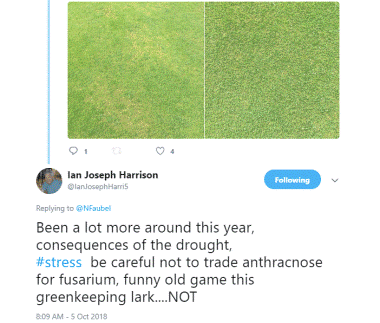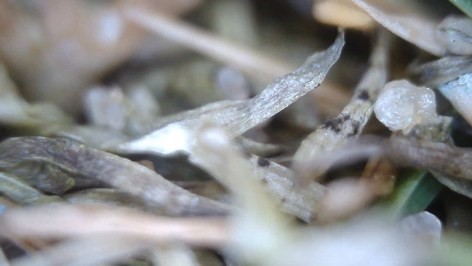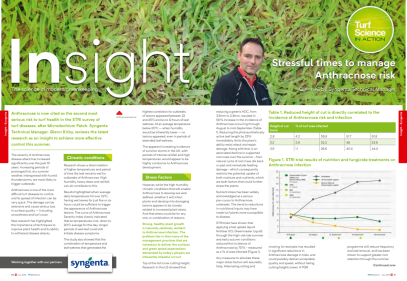Be careful not to trade Anthracnose for Fusarium
By Glenn Kirby, Technical Manager at Syngenta
In my role, I get the great pleasure of visiting many golf courses and talking to many people in the industry.
Last year there has been an overwhelming amount of concern about Anthracnose.
Most of the golf courses I visit, many of tweets I see and most of the conversations I have involve this dreaded and seemingly everlasting problem.

I saw this tweet from Ian Joseph Harrison replying to one of the many tweets flying around about trying to recover from this years late summer problems.
The brilliant quote “be careful not to trade anthracnose for fusarium” really got me thinking.

Anthracnose Turf Disease – up close
He’s absolutely right – September is never easy from a Microdochium patch perspective and this year Anthracnose has lingered on due to the very dry and stressful summer.
The danger now is the temptation to over feed greens in order to aid their recovery before the growth potential drops away completely.
This is an incredibly thin tightrope to walk though – don’t feed enough you go into winter thin with festering Anthracnose or over feed and go into Autumn very vulnerable to Microdochium?
Only you know your position, your sites problems and its historical disease pressure. Whilst the immediate priority of getting greens into the best condition possible is your current challenge it’s easy to overlook the reason your greens are in this position. The Anthracnose problem started way back in the early summer, high drought stress, maybe pushing things a little hard to achieve greens speeds or simply a deficient or ageing irrigation system that may have failed you.
Whatever the reason – many course managers are walking a thin line due to problems created earlier in the year.
I’m doing a lot of presentations at the moment where I’m really encouraging course managers to “Plan, Do, Review” or:
Plan – your fungicide programme – look at your site, your challenges, your budget
Do – Implement your plan with flexibility dependent on disease pressure
Review – Record your challenges (e.g Anthracnose – NOW) and review your management plan to see what you can improve on next year.

July’s article about Anthracnose – but is now the time to think about it?
It may prove many of your current challenges boil down to a irrigation failure, a club championship you pushed things a little too hard for or a need to please a particularly “green speed hungry” chairman of the management committee.
Now is the time to plan for next year, maybe there are some building blocks you can put in place to avoid this situation?
Whilst we can’t achieve perfection we can try and get a little closer year on year.